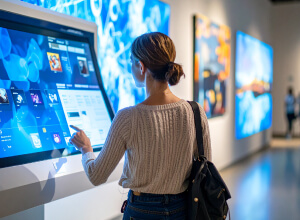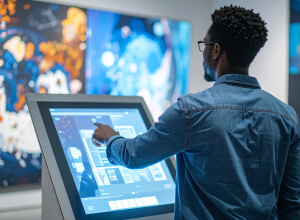How Non-Developers Can Create Interactive Signage

Discover how non-developers can create engaging interactive signage using intuitive tools, real-time data integration, & drag-and-drop interfaces.
Creating interactive signage has traditionally required high technical skills and coding expertise. However, with advancements in software, non-developers now have powerful tools at their disposal to design and deploy engaging digital experiences. This article explores how non-developers can harness these tools to create interactive signage.
Why Interactive Signage?

Interactive signage transforms static displays into engaging experiences, capturing attention and ramping engagement by providing personalized, dynamic content. This can be particularly beneficial in sectors such as retail, corporate environments, education, and public spaces, where engagement and user experience are essential.
The Challenge for Non-Developers
Historically, creating interactive content meant diving into coding languages like HTML, CSS, and JavaScript. This was a significant barrier for those without a technical background, often leading to reliance on professional developers or costly outsourced services.
Tools and Features Empowering Non-Developers
Modern software platforms offer a range of features that simplify the creation of interactive signage. Here are some of the critical features that non-developers can leverage:
1. Intuitive Drag-and-Drop Interface
Modern interactive signage platforms offer a drag-and-drop interface that makes designing content straightforward:
- Add Elements Easily: Users can drag and drop various elements such as images, videos, text, and web browsers onto a canvas.
- Customize Interactions: Elements can respond to user actions like tapping or swiping.
- Preview designs: What-you-see-is-what-you-get visuals make it easy to preview designs within the editor, vastly simplifying and speeding up reviews.
2. No Coding Required

These platforms permit the creation of complex interactions without writing code:
- Extensive configuration options: Customize the appearance and specify functional constraints to control every aspect of the design.
- Trigger and Action mechanism: Users can set up behaviors such as showing a new image when an item is tapped or playing a video when a button is pressed.
- Animate everything: Move, rotate, blur, shrink, hide anything on the screen, plus choreograph multiple animation effects to work in parallel.
3. Real-Time Integration
Integrating real-time data is essential for creating dynamic and relevant content:
- Media and Data Integration: On-demand integration with web-hosted data sources, enabling users to easily enrich their onscreen content.
- Live Data Feeds: Pull in data from social media, news feeds, or custom APIs to keep content up-to-date.
- Enhance with Artificial Intelligence: Submit predefined and user-generated prompts to the latest and most popular AI LLMs (large language models), collect the responses in real-time, and then customize them for display.
4. Collaboration and Sharing
These platforms often include features to facilitate collaboration:
- Project Sharing: Teams can collaborate by sharing projects, allowing multiple users to contribute.
- Localized Cloud Storage: Projects can be saved and accessed from anywhere, ensuring they are always backed up and accessible.
5. Analytics and Insights
.gif)
Understanding how users interact with signage is crucial for optimization:
- Track Interactions: Collect data for all interesting user interactions to feed analytics efforts.
- Analyze Performance: Visualize data to build insights about user behavior and make data-driven improvements to the content.
- Publish for visibility: Share real-time dashboards with all stakeholders.
6. Deployment and Management

Deploying and managing interactive signage has been streamlined:
- Deploy to any OS: Support any operating system favored by budget and preferences.
- Easy Deployment: Web-hosted tools simplify the push of interactive signage to devices worldwide.
- Remote Device Management: Monitor the health of in-the-field devices. Force a restart. Remotely update runtime software. Keep the network of devices healthy and online.
Practical Steps for Non-Developers
- Define Your Objectives: Clearly outline what you want to achieve with your interactive signage. Are you looking to educate, entertain, or sell?
- Choose the Right Platform: Select a software platform that offers the above mentioned features and suits your specific needs.
- Study Prebuilt Examples Templates: Be inspired by the excellent work of others. Use them as a starting point for your own projects.
- Utilize Compelling Media and Data: Source high-quality images, videos, and live data to create engaging and dynamic content.
- Test and Iterate: Regularly test your interactive signage to ensure it works as intended and make improvements based on user feedback and analytics.
Conclusion
With the right tools, non-developers can now create compelling and engaging interactive signage without learning to code. By leveraging features like drag-and-drop interfaces, real-time data integration, and built-in analytics, anyone can design, deploy, and manage dynamic digital experiences. This democratization of technology reduces costs and allows for more creative and timely content, ultimately enhancing user engagement and satisfaction.





